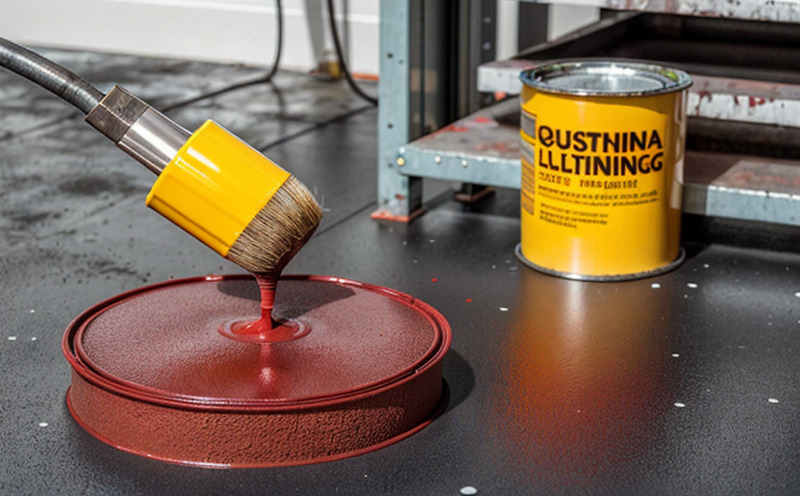ASTM D1308 Chemical Spot Resistance Testing of Paints Validation Method Development Test
The ASTM D1308 chemical spot resistance test is a critical method used to evaluate the resistance of paints against various chemicals, ensuring they can withstand exposure without compromising their integrity. This test is essential in industrial manufacturing and processing where paint coatings are subjected to harsh environments or contact with potentially corrosive substances.
This validation method development involves creating a reproducible testing protocol that accurately reflects real-world conditions. It includes the selection of appropriate chemical solutions, determination of optimal application methods, and establishment of clear acceptance criteria. The ASTM D1308 test is particularly important for ensuring quality control in industries such as automotive manufacturing, construction, and marine applications.
The process begins with thorough preparation of the paint samples. This involves applying the coating to a standard substrate according to specified thicknesses and curing conditions. Once dried, the coated samples are subjected to chemical exposure using various solvents or acids. The duration and concentration of these exposures are carefully controlled to simulate realistic industrial environments.
After exposure, the samples undergo visual inspection for any signs of deterioration such as discoloration, cracking, or loss of adhesion. Additionally, mechanical testing may be conducted to assess changes in hardness or flexibility. Acceptance criteria typically involve maintaining a certain percentage of original properties after exposure.
The ASTM D1308 test is not only crucial for quality assurance but also plays a vital role in compliance with international standards like ISO and ASTM. It helps manufacturers ensure their products meet regulatory requirements, thus enhancing product reliability and customer satisfaction.
By developing and validating this method, labs can provide clients with reliable data that supports informed decision-making regarding paint formulations and application techniques. This ensures paints not only perform well under laboratory conditions but also in real-world applications, thereby reducing the risk of failures during use.
The precision and accuracy of ASTM D1308 tests are paramount for maintaining consistent quality across different batches of paint. Through rigorous validation procedures, labs can identify any inconsistencies or variations that might arise due to manufacturing processes or raw material differences. This leads to more robust products capable of enduring diverse operational conditions in various sectors.
In summary, ASTM D1308 chemical spot resistance testing is an indispensable tool for industrial coatings and surface finishing industries. Its role extends beyond mere quality assurance; it forms part of a broader strategy aimed at ensuring product performance, compliance with standards, and ultimately, customer satisfaction.
Industry Applications
| Application Area | Description |
|---|---|
| Automotive Manufacturing | Ensuring paint durability against road contaminants like salt and fuel. |
| Construction Industry | Testing paints used in exterior wall coatings for resistance to acid rain and other chemicals. |
| Marine Applications | Evaluating coatings applied to ships or offshore structures against seawater and marine pollutants. |
| Plumbing & HVAC Systems | Checking paints used in plumbing fixtures for resistance to cleaning agents and solvents. |
| Furniture Manufacturing | Assessing interior paint finishes for their ability to withstand household chemicals like detergents. |
| Electrical Equipment | Ensuring paints used in electrical enclosures resist exposure to solvents and lubricants. |
| Petrochemical Industry | Evaluating coatings on storage tanks against aggressive hydrocarbon compounds. |
| Food Processing Plants | Testing paint coatings in food handling areas for resistance to cleaning agents and oils. |
Customer Impact and Satisfaction
The ASTM D1308 chemical spot resistance test significantly enhances customer satisfaction by providing robust evidence of a product’s performance. When manufacturers can demonstrate that their paints meet stringent industry standards, it builds trust with customers who rely on these products for critical applications.
By using validated testing methods like ASTM D1308, labs ensure consistent quality across batches, reducing the likelihood of batch-to-batch variations. This consistency is crucial in industries where product reliability is paramount, such as automotive manufacturing and construction.
Moreover, this test helps companies stay compliant with international regulations and guidelines, which can be a significant advantage in global markets. Compliance not only protects against potential legal issues but also enhances the reputation of both manufacturers and suppliers.
Clients benefit from more informed purchasing decisions when they have access to detailed reports generated from ASTM D1308 tests. These reports provide insights into how well the paint will perform under specific conditions, helping buyers select products that best suit their needs.
The ability to ensure product performance through rigorous testing also reduces warranty claims and returns, further contributing to higher customer satisfaction levels. By investing in such testing methodologies, companies demonstrate a commitment to excellence, which is highly valued by discerning customers.
Competitive Advantage and Market Impact
The ASTM D1308 chemical spot resistance test offers significant competitive advantages for manufacturers and suppliers of industrial coatings. By ensuring that paints meet or exceed industry standards, companies can differentiate themselves from competitors who may not adhere to such stringent testing protocols.
Staying ahead of regulatory changes is another key factor in maintaining a competitive edge. With the continuous evolution of environmental regulations and safety guidelines, having validated methods like ASTM D1308 ensures that products remain compliant with these evolving requirements. This foresight can open up new market opportunities and help capture untapped segments within existing markets.
Additionally, companies that invest in robust testing infrastructure gain an edge over those who do not. Such investments signal a commitment to quality and innovation, which are often highly regarded by stakeholders including investors, partners, and potential customers. This reputation can lead to increased market share as more businesses seek out reliable suppliers.
The ability to consistently deliver high-quality products through validated testing methods also fosters long-term relationships with loyal customers. Loyal clients are less likely to switch brands when they trust that the supplier will maintain consistent performance over time, leading to sustained business growth and profitability.





